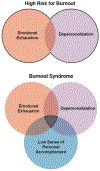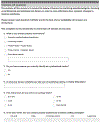Burnout Rate and Risk Factors among Anesthesiologists in the United States
- PMID: 33667293
- PMCID: PMC9430843
- DOI: 10.1097/ALN.0000000000003722
Burnout Rate and Risk Factors among Anesthesiologists in the United States
Abstract
Background: Physician burnout, widespread across medicine, is linked to poorer physician quality of life and reduced quality of care. Data on prevalence of and risk factors for burnout among anesthesiologists are limited. The objective of the current study was to improve understanding of burnout in anesthesiologists, identify workplace and personal factors associated with burnout among anesthesiologists, and quantify their strength of association.
Methods: During March 2020, the authors surveyed member anesthesiologists of the American Society of Anesthesiologists. Burnout was assessed using the Maslach Burnout Inventory Human Services Survey. Additional survey questions queried workplace and personal factors. The primary research question was to assess rates of high risk for burnout (scores of at least 27 on the emotional exhaustion subscale and/or at least 10 on the depersonalization subscale of the Maslach Burnout Inventory Human Services Survey) and burnout syndrome (demonstrating all three burnout dimensions, consistent with the World Health Organization definition). The secondary research question was to identify associated risk factors.
Results: Of 28,677 anesthesiologists contacted, 13.6% (3,898) completed the survey; 59.2% (2,307 of 3,898) were at high risk of burnout, and 13.8% (539 of 3,898) met criteria for burnout syndrome. On multivariable analysis, perceived lack of support at work (odds ratio, 6.7; 95% CI, 5.3 to 8.5); working greater than or equal to 40 h/week (odds ratio, 2.22; 95% CI, 1.80 to 2.75); lesbian, gay, bisexual, transgender/transsexual, queer/questioning, intersex, and asexual status (odds ratio, 2.21; 95% CI, 1.35 to 3.63); and perceived staffing shortages (odds ratio, 2.06; 95% CI, 1.76 to 2.42) were independently associated with high risk for burnout. Perceived lack of support at work (odds ratio, 10.0; 95% CI, 5.4 to 18.3) and home (odds ratio, 2.13; 95% CI, 1.69 to 2.69) were most strongly associated with burnout syndrome.
Conclusions: The prevalence of burnout among anesthesiologists is high, with workplace factors weighing heavily. The authors identified risk factors for burnout, especially perceived support in the workplace, where focused interventions may be effective in reducing burnout.
Copyright © 2021, the American Society of Anesthesiologists, Inc. All Rights Reserved.
Conflict of interest statement
Figures






Comment in
-
Burnout: The "Other" Pandemic.Anesthesiology. 2021 May 1;134(5):673-675. doi: 10.1097/ALN.0000000000003711. Anesthesiology. 2021. PMID: 33667300 No abstract available.
-
Burnout in Anesthesiologists: Reply.Anesthesiology. 2021 Dec 1;135(6):1157-1158. doi: 10.1097/ALN.0000000000003931. Anesthesiology. 2021. PMID: 34402811 No abstract available.
-
Burnout in Anesthesiologists: Comment.Anesthesiology. 2021 Dec 1;135(6):1157. doi: 10.1097/ALN.0000000000003930. Anesthesiology. 2021. PMID: 34402857 No abstract available.
References
-
- Shanafelt TD, Boone S, Tan L, Dyrbye LN, Sotile W, Satele D, West CP, Sloan J, Oreskovich MR: Burnout and satisfaction with work-life balance among US physicians relative to the general US population. Arch Intern Med. 2012;172(18):1377–1385. - PubMed
-
- Gundersen L: Physician burnout. Annals of internal medicine. 2001;135(2):145–148. - PubMed
-
- Shanafelt TD, Hasan O, Dyrbye LN, Sinsky C, Satele D, Sloan J, West CP: Changes in Burnout and Satisfaction With Work-Life Balance in Physicians and the General US Working Population Between 2011 and 2014. Mayo Clin Proc. 2015;90(12):1600–1613. - PubMed
-
- Shanafelt TD, West CP, Sinsky C, Trockel M, Tutty M, Satele D, Carlasare LE, Dyrbye LN: Changes in Burnout and Satisfaction With Work-Life Integration in Physicians and the General US Working Population Between 2011 and 2017. Mayo Clin Proc. 2019;94(9):1681–1694. - PubMed
-
- Maslach C, Jackson S, Leiter M: Maslach Burnout Inventory. 3rd ed. Palo Alto, CA: Consulting Psychologists Press; 1996.
Publication types
MeSH terms
Grants and funding
LinkOut - more resources
Full Text Sources
Other Literature Sources
Medical
Miscellaneous

